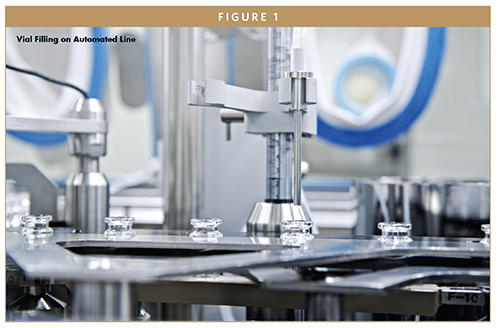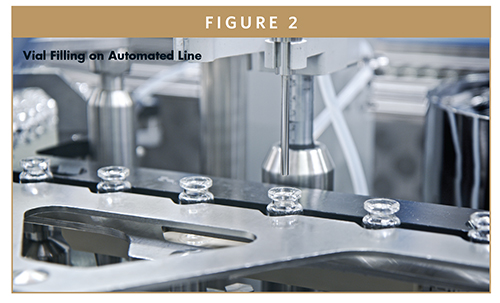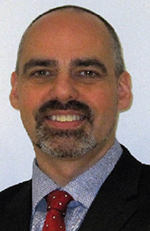Issue:October 2021
MANUFACTURING SOLUTIONS - Sterile Drug Product Manufacturing During a Global Pandemic
INTRODUCTION
The COVID-19 pandemic has presented public health challenges on almost every front imaginable. The scale of the public health response is unprecedented with no similarity to any other pandemic in modern times. Both privately and publicly funded researchers have applied innovation, speed, and scientific rigor to progress both therapeutics and vaccines in an unconstrained effort to halt the pandemic and save millions of lives. As biopharmaceutical companies race to find a cure or vaccine, they have become more synonymous with household brands.

At the same time, governments and not-for-profit organizations have invested heavily in vaccine and therapeutic development and delivery, while also working to adhere to the highest standards to deliver a safe and efficacious product for patients. In parallel, there have also been increased investments within countries around the world to establish long-term domestic infrastructures within countries that solidify the necessary supply chains in the event of future pandemics or other crises causing shortages of medical products.
Delivery of product to the health care front lines during the pandemic has been one of the greatest challenges facing the industry. Maintaining production requirements of existing essential medicines, in addition to expansion of the necessary capacity to supply billions of doses of vaccine to treat the global community, have accentuated the need for agility to ensure supply reliability. Manufacturers have responded to the challenges by changing how they work in numerous ways, which will keep global supply chains prepared for years to come.
COMPOUNDING RISKS
Prior to the COVID-19 pandemic, there was already a shortage of aseptic fill/finish capacity and relevant materials. Typically, components, such as syringes, vials, and stoppers, have four- to six-month lead times. Certain essential medicines used in the treatment of COVID-19 patients have also experienced shortages due to insufficient production capacity and the need to divert the primary components toward COVID-19 products to address the pandemic.
In the context of a pandemic, it is difficult to predict which company or entity will ultimately require the necessary capacity for manufacturing at scale. The vaccine or treatment that would ultimately be successful is unknown at the start of the pandemic. CDMOs have had to take a flexible approach to assigning capacity and coordinating the procurement of material, capitalizing on disposable equipment and continuous flow manufacturing to maximize throughput and expedite delivery to patients.
When the pandemic first surged, the lack of PPE for the world’s first responders was headline news. This shortage expanded beyond masks and included sterile gowning, gloves, booties, hairnets, and sleeves. One year later, PPE is rarely in the headlines, yet it remains an acute need for manufacturers as workforces have expanded and facilities are running 24/7. Demand remains high from manufacturing, health care, and other essential businesses, and nations continue to ramp up stockpiling measures.
SOURCING AT THE FOREFRONT
Procurement organizations have played a critical role in securing the affected supply chains and have been working extensively beyond normal hours to source essential raw materials, equipment, and supplies. Procurement has often had to bypass distributors and work directly with the original manufacturers to expedite and optimize supply. A high degree of competency in sourcing has been essential to identify suppliers that can meet the technical, quality, and supply-chain requirements of the situation, as well as finding creative solutions to resolve many apparently insurmountable supply-chain obstacles.
Robust collaboration across the health care network has been vital to secure goods and services to maximize the output of finished product around the world. Government agencies in the U.S., including the Biomedical Advanced Research and Development Authority (BARDA), have stepped in to secure access and prioritize manufacturers’ needs for vital equipment and materials to aid in expediting COVID-19 therapeutic and vaccine manufacture.
In most organizations, procurement quickly became recognized as a key function in the pandemic response as they worked to secure supply chains for continued operations and develop contingency plans, which could be shared across the enterprise. The plans often involved changing suppliers, finding alternative shipment routes, and where possible, qualifying secondary sources for materials and consumables.
Furthermore, the pandemic response caused supply restrictions as some countries reserved critical materials for their own domestic use. Some routinely available materials for manufacturing of pharmaceuticals were also being used in alternative production, such as alcohol in hand sanitizer, again constraining supply. For several reasons, many materials became scarce and prices rose sharply as demand outstripped supply. As time progressed through the pandemic, panic buying and political interventions have eased and additional capacities have been brought online by producers, meaning that supply chain constraints have eased to some degree.
RAPIDLY INCREASING MANUFACTURING CAPACITY
CDMOs have worked to improve throughput time, delivering more with the same amount of facility capacity. Capital invested in facilities, optimized manufacturing processes, and maximized batch sizes have all contributed to the improvements. This has all been greatly accelerated during the pandemic.
Careful, yet expedited, planning is the first step toward addressing the expanded fill/finish capacity needed to manufacture the COVID-19 vaccines. Leveraging large cross-functional teams to address the planning, combined with dedicated program management of the team, is necessary to capture all requirements.

Flexibility and agility to manage numerous changes to plan is crucial as processes and needs change in real time. Last-minute changes in suppliers can result in constantly moving timelines due to various impacts across the entire supply chain, including increasing or decreasing production of upstream portions of supply and a myriad of other possibilities. Iterative versions of plans must be captured with the continuous changes caused by all of the elements that come to play in manufacturing for a pandemic.
An often-overlooked area is warehousing – a critical component that is easily underestimated during a pandemic. There is a need to stockpile when materials become available and then hold the materials until they are needed. In products that are being developed quickly, the time when the material may be needed may not be precisely known. Development delays, manufacturing delays, or at the opposite extreme, accelerated timelines have to be anticipated. A range of storage conditions and temperatures will most likely be required. There can even be the need to hold bulk drug substance prior to manufacture or product until delivery can be made to the next step in the production process. Identifying contingency storage space adjacent to the manufacturing site is key.
TECHNOLOGY TRANSFER TO MANUFACTURING IN A FEW MONTHS
Technology transfer of commercial processes typically takes anywhere from 12 to 18 months for more complex manufacturing. The pandemic situation challenged and changed that standard. What once was routine became irrelevant. The pace at which organizations needed to operate uncovered three key areas to which focus was needed: (1) organization staffing, (2) public-private partnership, and (3) focused high-level joint management through true partnership between CDMOs and their clients.
First, skilled manufacturing personnel and labor in general has been very difficult to hire during the pandemic. The requirement to double the number of people working at a specific plant as quickly as possible is extremely challenging. There is a need to not only identify and hire people, but also train them in a highly regulated process like fill/finish, which requires aseptic techniques to ensure product quality and sterility is maintained. Deploying personnel from other sites in a company’s network, even temporarily from different roles, is one quick solution. Another quick solution is compensating people to work overtime hours beyond the norm. Hiring, similar to sourcing, has required expanded and unconventional efforts. Expanding efforts within normal channels, as well as outreach into nontraditional channels and hiring as quickly as possible once candidates are identified, has been critical.
Second, keeping close ties to regional and national regulators and authorities is essential. Without well-established relationships with regulatory agencies such as the FDA and support from governmental agencies like BARDA, such velocity would not be possible. BARDA partnered with U.S.-based suppliers to expand domestic manufacturing capacity, increasing availability as part of Operation Warp Speed.
True partnered approaches, in regard to management of a tech transfer, have been quite rare in the CDMO industry. More typically, the client and CDMO work through a more transactional effort to achieve the final outcome of the tech transfer. With the pace at which pharma companies need to move into manufacturing to be ready for immediate distribution at the time of the emergency use authorization for pandemic treatments or vaccines, transactional approaches simply are not workable. Development of a jointly owned management effort becomes more essential to ensure speed of treatments to patients while still ensuring quality and safety standards are maintained.
Expediting a technology transfer while a product is progressing through clinical development requires conducting activities in parallel that are usually conducted serially. Speed to market for emergency use authorization and immediate distribution, while maintaining rigor around quality standards, is far more critical during a pandemic than cost. In order to maintain product quality and safety as paramount, thorough risk analyses must be conducted to understand what activities could be expedited without compromising patient safety, including overlapping of clinical trial phasing, or manufacturing stockpiles of finished product prior to data on clinical success as examples.
SUMMARY
With vaccines and treatments now available and yet more on the horizon, the first major manufacturing hurdles have been crossed. However, the finish line is still in the distance. As organizations such as drug manufacturers around the world continuously evaluate how to effectively operate, the pandemic has provided a hard reality check. Companies have seen the necessity of strong sourcing/procurement functions to enable business operations. For at least the next few years, we anticipate constraints on aseptic fill/finish and potentially API manufacturing capacity. These constraints can be mitigated by having staffing flexibility when needs arise, enabling rapid technology transfers and adding surge capacity utilization. In addition, truly partnered approaches of pharmaceutical companies and their CDMO suppliers need to be the standard for managing and operating with speed, quality, and safety rigor to meet the needs of the global impact of the pandemic and to ensure focus on the end goal. Finally, maintaining strong relationships with regulatory bodies around the world enables a strong public-private partnership both during and post pandemic, with patients as the shared motivational force to execute and deliver.

Ankit Agrawal is the Senior Director of Global Commercial Strategy at Curia. He began his career in a clinical setting and has a 10-year history of leading corporate transformations at companies to develop and manufacture vital drugs for patients globally. He earned his MSc in Health Care Policy & Management from Carnegie Mellon University and his BSc in Biotechnology from the University of Nebraska Omaha.

Jonothan Hamer is Vice President of Global Procurement at Curia, where he is designing and implementing Curia’s roadmap to a World Class Procurement organization. Previously, he served at Abbott Laboratories as Senior Director of Procurement. Career highlights include the discovery of Substance P as the mediator in colitis through radioimmunoassay during a study of peptide expression in visceral afferents. He was also involved in lowering the total costs of materials in the world’s first AIDS drug to enable poorer countries to afford the medicine. He earned his BSc at Liverpool University in the United Kingdom.

Dr. Ronald Aungst is the Senior Director of Global Project Management at Curia and responsible for several fill/finish programs in the company’s COVID-19 manufacturing efforts. He began his career at Curia working in medicinal chemistry and has expanded his breadth of knowledge into the pharmaceutical development and cGMP manufacturing platforms within the company, assuming various technical and commercial roles within the company over the past 18 years. He earned his PhD in Synthetic Organic Chemistry from Pennsylvania State University and his BA degrees in both Chemistry and Biology from Lycoming College.

Dr. Barbara Solow is Vice President of Business Development & Government Contracting at Curia. She has a 20-year history of senior leadership roles at companies to develop and manufacture products for infectious diseases, including anthrax, H5N1 and H1N1 influenza, Ebola, Zika, and most recently, COVID-19. She earned her PhD in Biochemistry from Virginia Polytechnic Institute and State University.
Total Page Views: 4318









